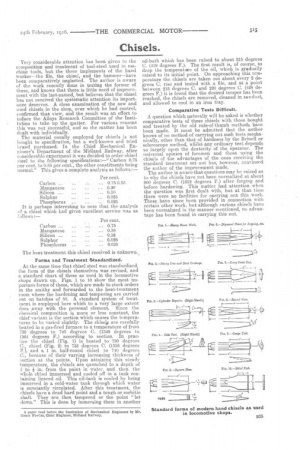Chisels.
Page 9

If you've noticed an error in this article please click here to report it so we can fix it.
Very considerable attention has been given to the composition and treatment of tool-steel used in machine tools, but the three implements of the hand worker—the file, the chisel, and the hammer—have been comparatively neglected. The author is aware of the work recently done in testing the former of these, and knows that there is little need of improvein entwith the last-named, but believes that the chisel has not received the systematic attention its importance deserves. A close examination of the new and used chisels in the shop, over which he had control, confirmed that view, and the result was an effort to induce the Alloys Research Committee of the Institution to take up the 'patter. For various reasons this was not successful, and so the matter has been dealt with individually.
The material usually employed for chisels is not bought to specification, but a well-known and tried brand purchased. In the Chief MechanicaL Enaineer's Department of the Midland Railway, after considerable experiment it was decided to order chisel steel to the followingspecifications-a—" Carbon 0.75 per cent. to 0.85 per cent., the other constituents being normal." This gives a complete analysis as follows:— Per cent.
Carbon ... ... 0.75-0.8S Manganese ... Silicon .... ... 0.10 Sulphur 0.025 Phosphorus ... -... 0.025 Per cent.
Carbon ... 076 Manganese ss 0.38 Silicon ...
Sulphur ... 0.028 Phosphorus ... 0.026 It is perhaps interesting to note that the analysis of a chisel whieh had given excellent service was as f ollows The heat treatment this chisel received is unknown., Forms and Treatment Standardized.
At the same time that chisel steel was standardized, the form of the chisels themselves was revised, and a standard chart of these as used in the locomotive shops drawn up. Figs. 1 to 10 show the most important forms of these, which are made to stock orders in the smithy and forwarded to the heat-treatment room where the hardening and tempering are carried out on batches of 50. A standard system of treatment is employed here which to a very large extent does away with the personal element. Since the chemical composition is more or less constant, the chief variant is the section which causes the temperatures to be varied slightly. The chisels are carefully heated in a gas-fired furnace to a temperature of from 730 degrees to 740 degrees C. (134-6 degrees to 1364 degrees F.) according to section. In practice the chisel (Fig. 1) is heated to '7:10 degrees (1, chisel (Fig. 2) to 735 degrees C. (1355 degrees F.), and a 1 in. half-round chisel to 740 degrees C., because of their varying increasing thickness of section at the points. Upon attaining this steady temperature, the chisels are quenched to a depth of ii to in. from the point in water, and then the whole chisel immersed and cooled off in a, tank containing linseed oil. This oil-tank is cooled by being immersed in a cold-water tank through which water is constantly circulated. After this treatment, the chisels have a dead hard point and a tough or sorbitio shaft. They are then tempered or the point "let down." This is done by immersing them in another oil-bath which has been raised to about 215 degrees C. (419 degrees F.). The first result is, of course, to drop the temperature of the oil, which is gradually raised to its initial point. On approaching this temperature the chisels are taken out about every 2 degrees C. rise and tested with a file, and at a point between 215 degrees C. and 220 degrees C. (428 degrees F.) it is found that the desired temper has been reached, the chisels are removed, cleaned in sawdust, and allowed to cool in an iron tray.
Comparative Tests Difficult.
A question which naturally will be asked is whether comparative tests of these chisels with those bought and treated by the old rule-of-thumb methods have been made. It must be admitted that the author knows of no method of carrying out such tests meehanically, other than that of hardness by the Brinell or scleroscope method, whilst any ordinary test depends so largely upon the dexterity of the operator. The ,universal opinion of foremen and those using the chisels of the advantages of the ones receiving the standard treatment set out has, however, convinced the author of the improvement made. The author is aware that questions may be raised as to why the chisels have not been normalized at about 900 degrees C. (1652 degrees F.) after forging and before hardening. This matter had attention when the question was first dealt with, but at that time . there were no facilities for carrying out this work. These . have since been provided in connection with certain other work, but although various chisels have • been normalized in the manner mentioned, no a.dvantage has been found in carrying this out.




















